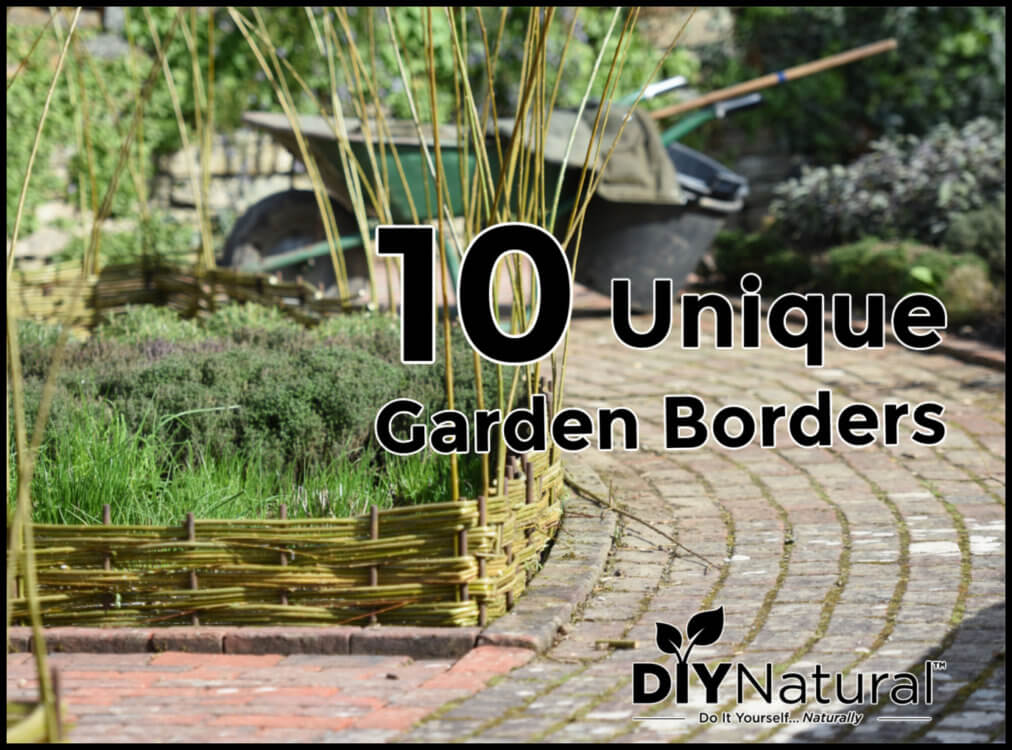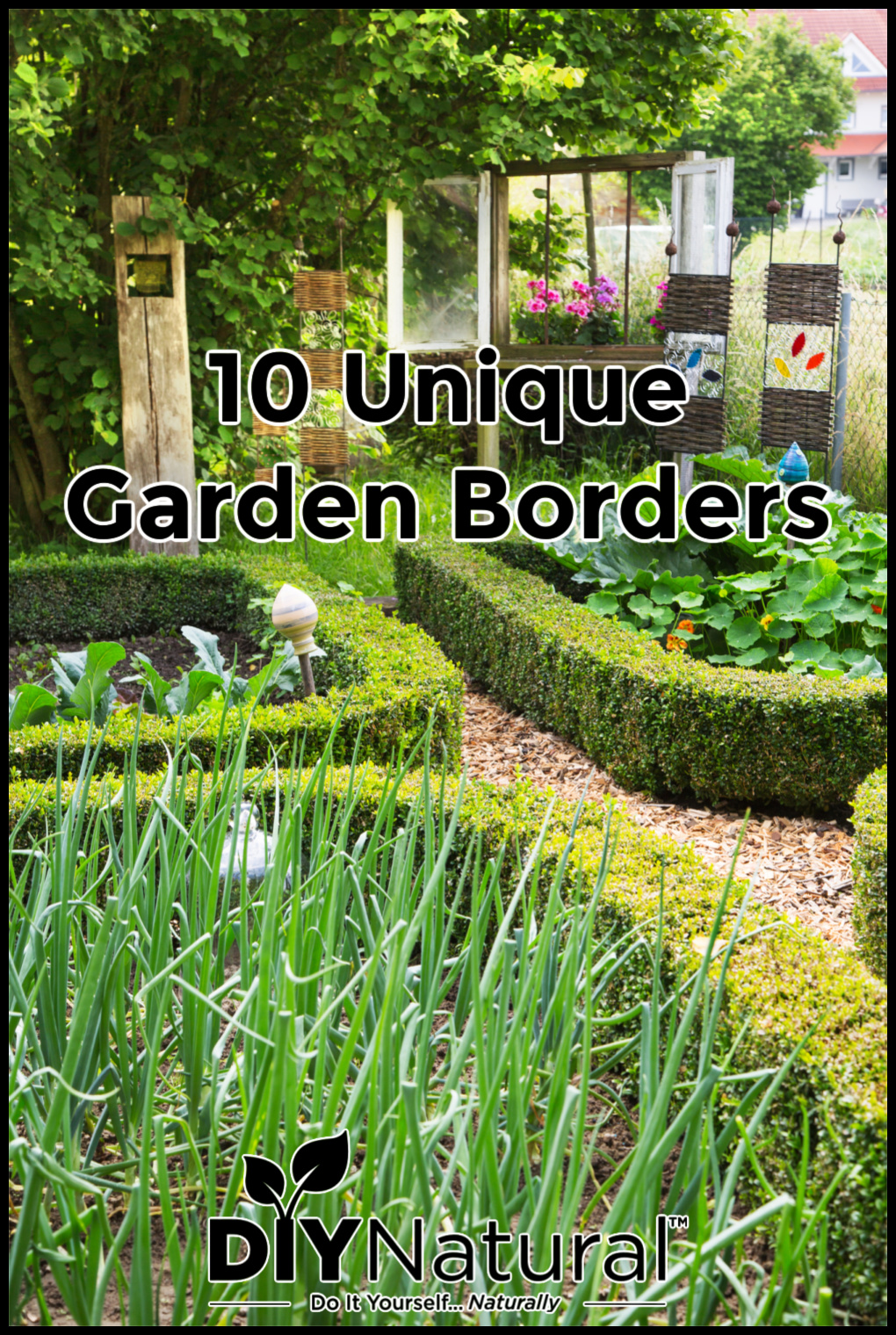
I love my garden but didn’t want garden borders like everyone else so I made this list of 10 unique and fun garden border edging ideas. Enjoy!
I bought my first home last August. Yay me! I have all kinds of visions for the yard, but I’m quickly finding that Some are really expensive, some are too standard, but some..well..they are a bit unusual. But then, why be normal!
Why Build Garden Borders?
Of course, borders on gardens are done for many reasons. First, aesthetic value, which gives you the creative freedom to do what you want. Secondly, borders keep your plants contained. Some plants for example, like mints, tend to spread. By keeping them contained in a garden with borders, it helps to keep them from spreading. Further, the main reason I wanted borders on my gardens is to keep the mulch in and the lawn out. I’m working on hugelkultur type gardens with branches and mulch under the soil. Moreover, borders help keep all the mulch and soil from getting all over the place.
Garden Border Edging Ideas
Here are 10 ideas for borders for gardens in your yard. Don’t limit yourself to these, think outside the box!
1. Wine Bottles
Dig a ditch around your garden bed that is about 2/3 the height of your bottles. Next, turn the bottles upside down and backfill around them. Make sure to keep the bottle about 4-5 inches above the surface of the soil. Make it your own by using all one color or assorting the colors for variety. Lastly, if you don’t drink a lot of wine, contact your neighbors or check out Freecycle!
2. Small Bricks
To make garden borders using bricks, simply dig a ditch like above, but only about a third of the length of the brick. Then place your bricks on an angle in the ditch. Be sure to layer each one against the previous brick, creating a sawtooth type of effect. Finally, fill in once you have all the bricks in place.
3. Rocks
Does your area have some cool indigenous stones? Or do you have some rocks you’ve collected over the years? Use them as a border! For instance, you can stack the rocks to the height you want and fill in the soil on the inside. Or, if the rocks are thin, like flagstone, you can put them up on end and fill in around them. I have rocks from a lot of places I’ve been and a garden border is a great way to showcase them. Finally, I plant creeping thyme in the cracks to make the border more interesting.
4. Short Logs
Choose logs mostly all the same diameter, usually around 4 inches across. Make the logs around 8 inches long. Bury half the log in the soil and fill in around them. You can make them all the same height or vary the heights for interest. You can do this with cut-off 4x4s. Tiles work very well. Our local Habitat for Humanity Restore often has tiles available. Use all the same colors or choose different colors for variety.
5. Terracotta Pipes
These make interesting garden borders! Cut them similar to the logs above. But-terracotta pipes have holes. You can plant something vining in the tops, like nasturtiums.
6. Cob Border
Make your own shapes and designs with cob. You can literally make this border anything you like. Add stones or glass pieces for a different look.
7. Woven Branches
This is one of my favorite rustic garden borders! Simply drive some stakes into the ground at regular intervals. Weave thin branches in between the standards. Branches from trees like a willow will stay pliable for a long time and could possibly root, leaving you with a living border.
8. Plates
Have some old, mismatched plates? Bury them halfway in the soil. I got a bunch at a thrift store for a dime each and made a cool border with them.
9. Gabions
Make a fence using fencing material with small holes, like hardware cloth. Once this is done, make another fence about 8 inches from the first one. Like using cob, you can make this garden border straight or create some interesting shapes. Once the fence is done, then fill it with rocks. Use all one type or vary the sizes.
10. Shells
If you live in an area or have access to large shells, use these as a border. Fill in around them as you put them in place. Note that as shells start to deteriorate, they could raise the soil pH. You may need to adjust the pH over time.
Go Put Your Signature On Your Garden
Garden borders don’t have to be boring. Make your garden border edging something fun and unique!
*******




It would have been nice to have photos to go with this post. What are gabions?
Totally agree with your comment, came here to see pics and get inspired.. ?
not being rude…..google it? her description is spot on, but without a visual picture in your head to start with, it probably isn’t clear. They use them on highways (in a much larger size). Great idea if you live in a rocky place.
Thank you for a very interesting article about an spect of the garden that is often neglected or completely forgotten. I would’ve appreciated it even more though, had you posted a photo alongside each option.